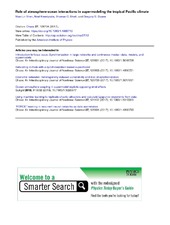| dc.contributor.author | Shen, Mao-Lin | |
| dc.contributor.author | Keenlyside, Noel | |
| dc.contributor.author | Bhatt, Bhuwan Chandra | |
| dc.contributor.author | Duane, Gregory | |
| dc.date.accessioned | 2018-07-05T14:55:47Z | |
| dc.date.available | 2018-07-05T14:55:47Z | |
| dc.date.issued | 2017-12-29 | |
| dc.Published | Shen M, Keenlyside N, Bhatt BC, Duane G. Role of atmosphere-ocean interactions in supermodeling the tropical Pacific climate. Chaos. 2017;27(12) | eng |
| dc.identifier.issn | 1089-7682 | en_US |
| dc.identifier.issn | 1054-1500 | en_US |
| dc.identifier.uri | https://hdl.handle.net/1956/17876 | |
| dc.description.abstract | The supermodel strategy interactively combines several models to outperform the individual models comprising it. A key advantage of the approach is that nonlinear improvements can be achieved, in contrast to the linear weighted combination of individual unconnected models. This property is found in a climate supermodel constructed by coupling two versions of an atmospheric model differing only in their convection scheme to a single ocean model. The ocean model receives a weighted combination of the momentum and heat fluxes. Optimal weights can produce a supermodel with a basic state similar to observations: a single Intertropical Convergence zone (ITCZ), with a western Pacific warm pool and an equatorial cold tongue. This is in stark contrast to the erroneous double ITCZ pattern simulated by both of the two stand-alone coupled models. By varying weights, we develop a conceptual scheme to explain how combining the momentum fluxes of the two different atmospheric models affects equatorial upwelling and surface wind feedback so as to give a realistic basic state in the tropical Pacific. In particular, we propose a mechanism based on the competing influences of equatorial zonal wind and off-equatorial wind stress curl in driving equatorial upwelling in the coupled models. Our results show how nonlinear ocean-atmosphere interaction is essential in combining these two effects to build different sea surface temperature structures, some of which are realistic. They also provide some insight into observed and modelled tropical Pacific climate. | en_US |
| dc.language.iso | eng | eng |
| dc.publisher | AIP Publishing | en_US |
| dc.relation.uri | http://aip.scitation.org/doi/pdf/10.1063/1.4990713 | |
| dc.title | Role of atmosphere-ocean interactions in supermodeling the tropical Pacific climate | en_US |
| dc.type | Peer reviewed | |
| dc.type | Journal article | |
| dc.date.updated | 2018-03-28T10:01:43Z | |
| dc.description.version | publishedVersion | en_US |
| dc.rights.holder | Copyright the authors | en_US |
| dc.identifier.doi | https://doi.org/10.1063/1.4990713 | |
| dc.identifier.cristin | 1545181 | |
| dc.source.journal | Chaos | |
| dc.relation.project | Notur/NorStore: nn9385k | |
| dc.relation.project | Notur/NorStore: nn9039k | |
| dc.relation.project | Notur/NorStore: ns9039k | |
| dc.relation.project | Notur/NorStore: nn9207k | |
| dc.relation.project | EC/H2020: 648982 | |
| dc.relation.project | Notur/NorStore: ns9207k | |
| dc.relation.project | EC/H2020: 658602 | |
